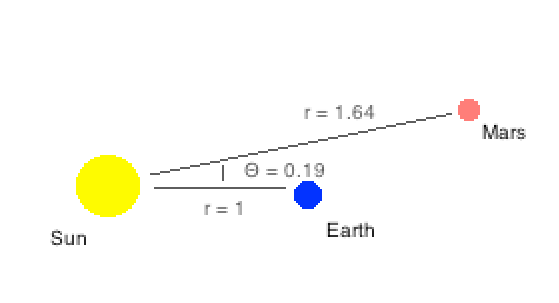
SUNY Geneseo Department of Mathematics
Math 222 01
Spring 2015
Prof. Doug Baldwin
Complete by Tuesday, May 5
Grade by Monday, May 11
This problem set further develops your understanding of parametric equations, and reinforces that of polar coordinates.
This problem set is based on material in sections 11.1 through 11.5 of our textbook. We discussed or will discuss this material in classes between April 22 and April 30.
Solve each of the following problems:
At the end of March and beginning of April, 2014, Earth was overtaking Mars as the two planets orbited the sun. In particular, on March 19, 2014, the configuration of the planets looked something like the following diagram. In this view, both planets orbit counterclockwise, so Mars is slightly ahead (by 0.19 radians) of the Earth in their respective orbits. The diagram also shows the radii of the orbits in astronomical units: 1 for Earth, and 1.64 for Mars (1 astronomical unit is defined to be the average radius of Earth’s orbit).

Part A. Assuming that Earth and Mars follow precisely circular orbits, and orbit in the same plane, derive parametric equations giving each planet’s x and y coordinates relative to a coordinate system with the sun at its origin. You may use any line through the sun that you wish as the x axis (e.g., the line from the sun to Earth on March 19). Let the t parameter for these equations represent time in days from March 19. Assume that Earth completes one orbit of the sun in 365 days, and Mars completes one orbit in 687 days.
Part B. Using the equations derived in Part A, derive another equation that gives the distance between the planets as a function of time.
(I used the model you are building in this question in another course in spring 2014 in which students actually calculated when the two planets would come closest to each other. You could, in principle, do the same using the equation you derive in Part B, although you don’t have to. The model was quite accurate for the few weeks in 2014 when it mattered, although by now inaccuracies due to the basic assumptions have probably accumulated to the point where your equations aren’t terribly good predictors of the planets’ present positions.)
Section 11.2, exercise 30 (find the length between t = 0 and t = π/3 of the curve given by the parametric equations x = ln( sect + tant ) - sint and y = cost).
Section 11.3, exercise 36 (find a Cartesian equivalent of the polar equation r2 = 4r sinΘ).
Section 11.5, exercise 2 (find the area bounded by the circle r = 2 sinΘ and the lines Θ = π/4 and Θ = π/2.)
Section 11.5, exercise 22 (find the length between Θ = 0 and Θ = π of the curve r = eΘ / √2).
I will grade this exercise in a face-to-face meeting with you. During this meeting I will look at your solution, ask you any questions I have about it, answer questions you have, etc. Please bring a written solution to the exercise to your meeting, as reading through it will help me know what to focus on in the rest of the meeting.
Sign up for a meeting via Google calendar. If you worked in a group on this exercise, the whole group should schedule a single meeting with me. Please make the meeting 15 minutes long, and schedule it to finish before the end of the “Grade By” date above.
My basic expectation in grading this exercise is that your solution will show that you understand how to solve each problem, although there may be arithmetic or copying mistakes, inefficient solution methods, incorrect or irrelevant statements incidental to the solution, or similar minor mistakes. If you understand how to solve all the problems and have no minor errors, I will consider the solution to be in between “what I expect” and “surprisingly beyond expectations.” I will consider solutions to be 3/4, 1/2, 1/4, or none of what I expect according to what (rough) fraction of the problems your solution shows understanding of, although I will raise grades slightly if it is clear by the end of your grading meeting that you have come to understand things you didn’t understand when you arrived at the meeting.